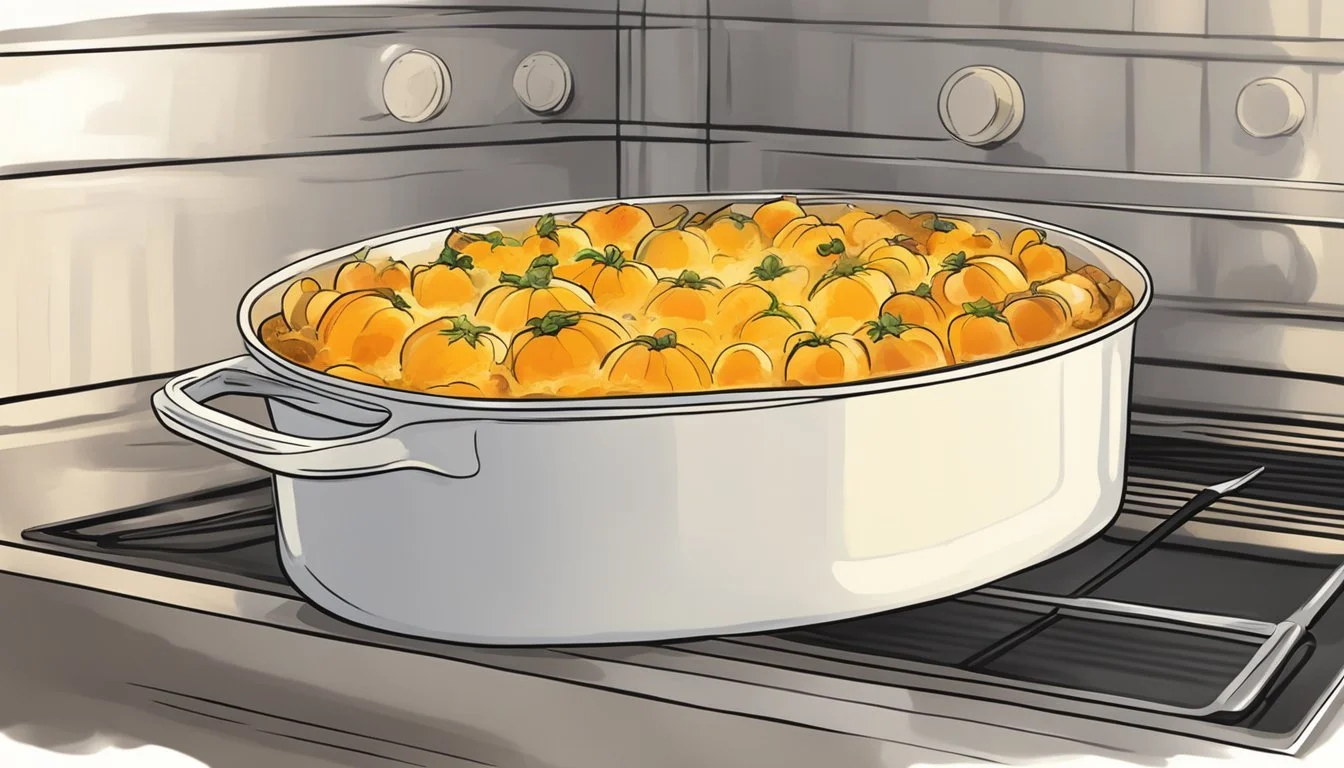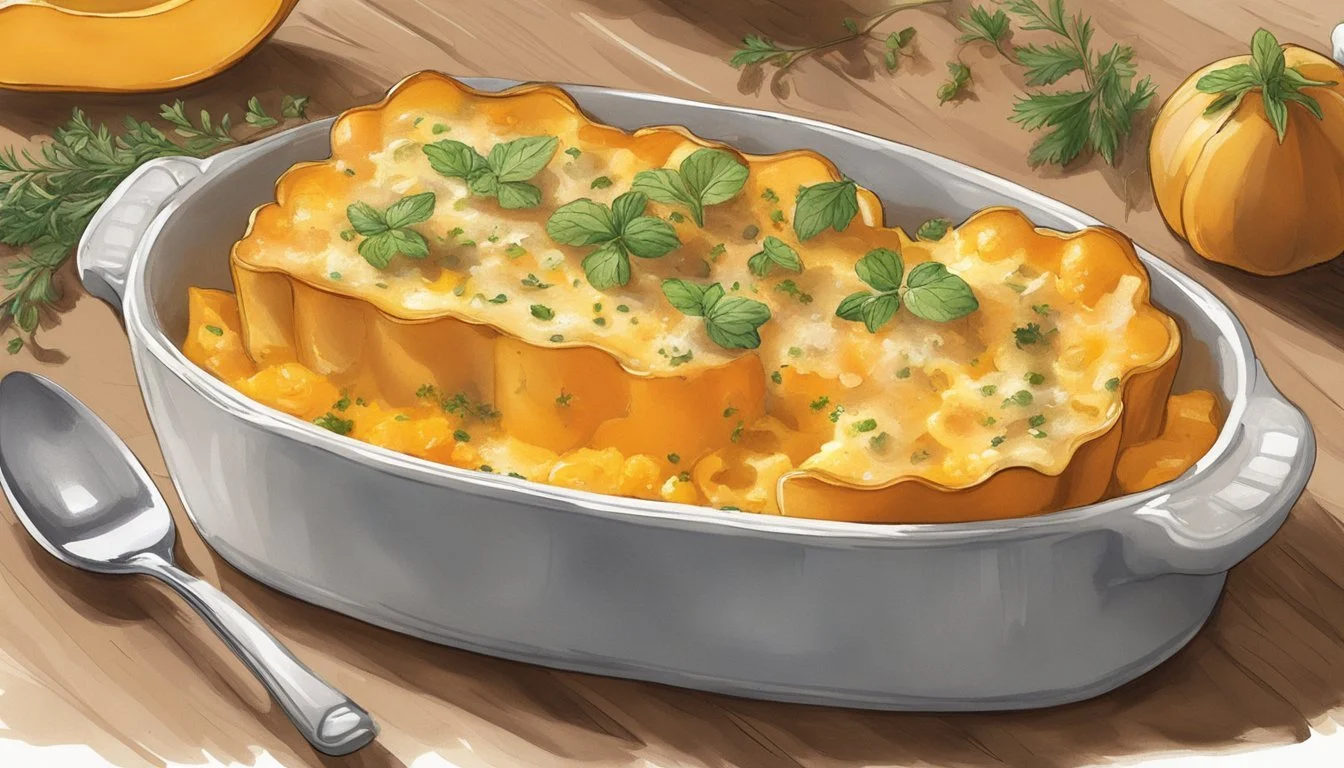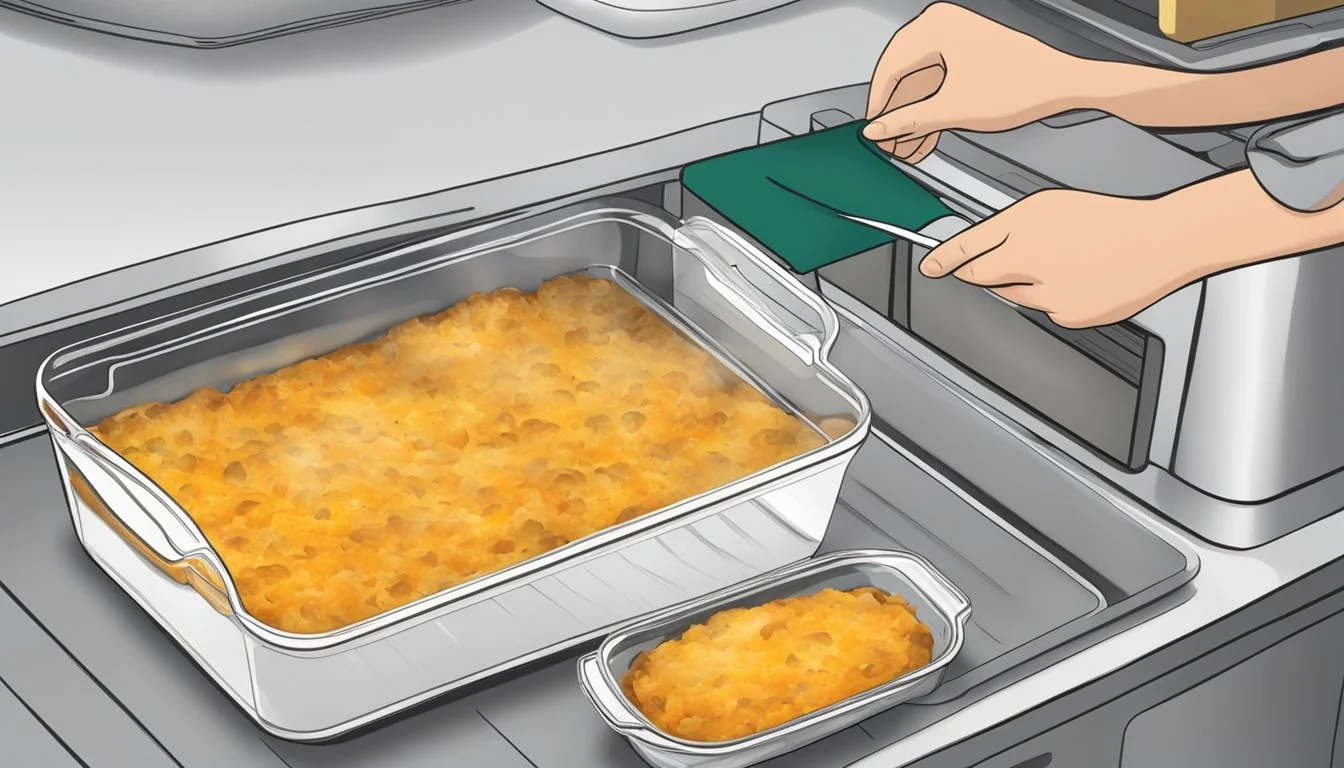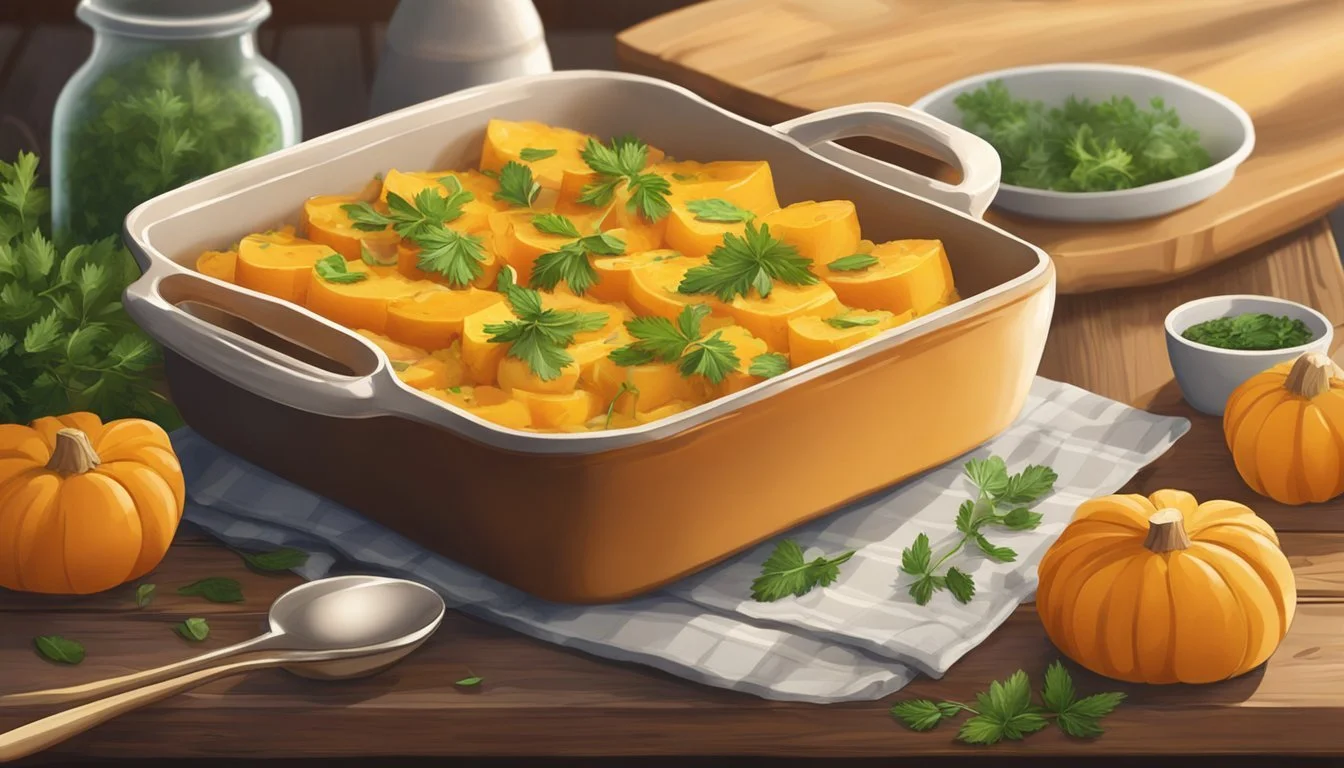How to Reheat Butternut Squash Gratin
Best Methods Explained
Reheating butternut squash gratin can seem tricky, but it’s straightforward if you know the right methods. Whether you're enjoying leftovers from a festive dinner or prepping meals ahead of time, maintaining the dish's flavor and texture is key. Using an oven is typically the best way to reheat butternut squash gratin to preserve its creamy consistency and caramelized edges.
Simply preheat your oven to 375°F, place the gratin in an oven-safe dish if it isn’t already in one, and cover it with aluminum foil to retain moisture. This method ensures that the gratin warms evenly without drying out, giving you that delightful combination of tender squash and savory toppings.
For those short on time, the microwave is a quicker alternative. However, for the best results, a consistent, gentle reheating in the oven truly brings out the rich flavors and textures of the butternut squash gratin.
Understanding Butternut Squash Gratin
Butternut Squash Gratin is a delightful dish that combines the natural sweetness of squash with creamy and savory elements. It is enhanced by the preparation process and the specific ingredients used, offering a tasty and nutritious meal.
Composition of Butternut Squash
Butternut squash is the foundation of this gratin. It has a distinct, mildly sweet flavor and smooth, creamy texture when cooked.
Slice the squash into thin pieces for even cooking. Its rich orange color indicates a high content of beta-carotene, which is converted to Vitamin A in the body.
Nutritional Benefits:
Low in calories
High in vitamins (A, C)
Provides dietary fiber
Key Ingredients in Gratin
The gratin aspect of the dish involves layering the squash with other ingredients that meld together during baking. Key components include:
Butter: Adds richness and helps sauté aromatics like garlic and leeks.
Cream: Contributes to the creamy texture, balancing the sweetness of the squash.
Cheese: Parmesan or Gruyère commonly provide saltiness and depth of flavor.
Herbs and Spices: Infuse the dish with additional layers of taste.
Preparation Tip: Keep moisture with a water bath or foil cover to ensure a creamy outcome.
Nutritional Value
Butternut Squash Gratin offers a well-rounded nutritional profile:
Calories: Moderate, depending on the amount of butter and cream used.
Protein: Provided primarily by cheese.
Carbohydrates: Sourced from the squash.
Fats: From butter and cream, contributing to satiety.
Sodium: Variable based on seasoning and cheese types.
Fiber: High, aiding in digestion.
This combination makes the gratin both a flavorful and nutritious dish that balances taste with health benefits. The right balance of creamy textures and nutrient-rich ingredients creates a comforting yet healthy meal option.
Pre-Reheating Preparation
Before reheating butternut squash gratin, it is essential to follow a few preparatory steps to ensure the dish's texture and flavor remain intact. Key steps include letting the dish reach room temperature, preheating the oven, and preparing the baking dish.
Bringing Dish to Room Temperature
Allowing the butternut squash gratin to come to room temperature is crucial for even reheating. Remove the dish from the refrigerator and set it on the counter for about 30-45 minutes. This helps prevent sudden temperature changes that could affect texture.
Uncover the gratin if it has been stored with a lid or plastic wrap, as condensation can alter the dish's consistency. Pat any excess moisture on the surface with a paper towel.
By ensuring the gratin reaches room temperature, you promote even heating and reduce the risk of drying out or overcooking.
Preheating the Oven
Preheating the oven is a critical step for consistent results. Set the oven to 350°F (175°C) slightly higher if the recipe suggests it, and allow it to reach the full temperature before placing the dish inside.
Proper preheating ensures that the butternut squash gratin warms evenly. Using a thermometer to check the oven's internal temperature can be helpful, especially if the oven dial's accuracy is in question.
During this waiting period, you can use the time to prepare the baking dish and other necessary items, ensuring the entire process runs smoothly.
Preparing the Baking Dish
Choose an oven-safe baking dish that allows for even heat distribution. This is particularly important if transferring the gratin to a new dish. Grease the baking dish lightly with butter or oil to prevent sticking.
Steps:
Grease the baking dish.
Cover with aluminum foil.
Add water to the bottom if needed (a few tablespoons).
The foil traps moisture and ensures the gratin remains creamy. If possible, use the same dish the gratin was initially baked in to maintain consistency in texture and flavor. This method will help to retain the dish's integrity during reheating.
Reheating Techniques
Different methods cater to various preferences and available kitchen tools. Each technique has its own approach for ensuring that butternut squash gratin remains delicious and retains its texture.
Oven Reheating Method
To reheat butternut squash gratin in the oven, preheat the oven to 350°F (175°C). This temperature helps achieve a gentle and even heat distribution.
Cover the gratin with aluminum foil to maintain moisture, which prevents drying out. Place it in an oven-safe dish if it isn't already in one.
Heat for 20-25 minutes, checking halfway through to ensure even heating. The gratin should be warmed through, and a fork should easily pierce the squash without resistance.
Microwave Reheating Method
For quick reheating, the microwave can be very effective. Place your butternut squash gratin in a microwave-safe dish.
Cover with a microwave-safe cover or vented plastic wrap to prevent splatters and retain moisture. Set the microwave on medium power to avoid overcooking.
Heat in 2-3 minute intervals, stirring if necessary, until it is hot throughout. Be cautious as the texture might not remain as firm as with oven reheating.
Skillet Reheating Method
Using a skillet is another way to reheat butternut squash gratin, especially if one prefers a slight crisp on the edges. Heat a skillet over medium heat and add a small amount of butter or oil to prevent sticking.
Place the gratin in the skillet, and cover it with a lid to help retain moisture. Cook for 8-10 minutes, turning occasionally to heat evenly.
Monitor closely to avoid burning and ensure the squash is heated thoroughly. This method can enhance the texture with a slight crunch.
Ensuring Optimal Texture and Flavor
Achieving a perfect balance of moisture, crispiness, and seasoning is essential when reheating butternut squash gratin. Follow these guidelines to keep your gratin delicious and appetizing.
Maintaining Moisture
To keep the butternut squash gratin moist, preheat the oven to 350°F (175°C). Place the gratin in an oven-safe dish if it’s not already in one. Cover the gratin with aluminum foil to trap steam and prevent dryness.
Adding a small amount of cream or broth before covering can also help maintain moisture. Reheat for about 20-25 minutes, checking occasionally to ensure it doesn't dry out. This method will help retain the creamy consistency and moist texture of the gratin.
Enhancing Crispiness
Achieve a delightful crispy top by focusing on the proper methods and ingredients. After maintaining moisture, uncover the gratin for the last 5-10 minutes of reheating. This will allow the top to brown and crisp.
Incorporate breadcrumbs mixed with melted butter, garlic, and herbs such as sage. Sprinkle this mixture over the gratin before reheating to add a flavorful and crispy topping. For extra richness, add a layer of grated Gruyere cheese and place under the broiler for a few minutes until golden brown.
Seasoning Adjustments
Reheating often requires adjusting seasonings to preserve flavor. Start by tasting the reheated gratin to evaluate if it needs additional seasoning. Common seasonings include a pinch of salt, black pepper, and a dash of nutmeg to enhance the dish's flavors.
A light drizzle of olive oil can refresh flavors and add a subtle richness. Reintroduce herbs like sage or a hint of minced garlic to brighten the taste profile. Ensure these adjustments are made gradually to avoid overpowering the delicate butternut squash flavors.
Safety and Storage Tips
Proper storage and handling of butternut squash gratin ensure its longevity and edibility. Careful attention to these aspects helps maintain the dish's flavor and texture.
Proper Storage Practices
Refrigerate butternut squash gratin within two hours of cooking. Use airtight containers or tightly cover the dish with aluminum foil to prevent air exposure.
Store the gratin in the coldest part of the refrigerator, at or below 40°F (4°C). For longer storage, freezing is an option. Transfer individual portions into freezer-safe containers or bags, ensuring they are tightly sealed to prevent freezer burn.
Label the packages with the date of storage for easy tracking. Thawed gratin should be consumed within 24 hours for best quality.
Preventing Contamination
Wash hands thoroughly before handling the gratin to avoid introducing bacteria. Use clean utensils and containers when transferring the gratin into storage. Avoid cross-contamination by keeping the gratin separate from raw meats, seafood, and poultry in the refrigerator.
If using a microwave to reheat, ensure the gratin reaches an internal temperature of 165°F (74°C) to kill any potential bacteria. Storing and reheating properly can significantly reduce the risk of foodborne illnesses.
Determining Edibility
Before consuming leftover butternut squash gratin, check for any off odors or visible mold. If the gratin has an unusual smell or discoloration, it should be discarded immediately.
Evaluate texture; a mushy consistency or excessive dryness could also indicate spoilage. Taste a small portion if uncertain, but spit it out if it seems off.
Leftover gratin should ideally be consumed within 3-4 days when stored in the refrigerator. Always err on the side of caution if uncertain about the gratin's edibility.
Pairing and Serving Suggestions
Butternut squash gratin pairs beautifully with a variety of side dishes and beverages, making it a versatile addition to any holiday meal. Thoughtful presentation can elevate the dish, turning it into a centerpiece on your table.
Complementary Side Dishes
To balance the richness of butternut squash gratin, consider serving it alongside green salad with a light vinaigrette. This provides a refreshing contrast. Traditional scalloped potatoes can offer a double dose of comfort foods, ideal for Thanksgiving or Christmas meals.
Steamed green beans or asparagus with a simple seasoning of salt, pepper, and a touch of lemon can add a vibrant color and crisp texture to your holiday table. For a classic touch, include sage as a garnish to both the gratin and the vegetables.
Wine and Beverage Pairings
A well-chosen beverage can enhance the flavors of your butternut squash gratin. White wine, particularly varieties like Chardonnay or Sauvignon Blanc, complement the creamy texture of the gratin with their bright acidity. These wines add a refreshing balance to the dish's richness.
For non-alcoholic options, consider serving a sparkling apple cider. Its crisp and slightly sweet profile can pair nicely with the savory elements of the gratin. Herb-infused water with hints of mint or sage can also be a delightful accompaniment.
Presentation Tips
Elevate the visual appeal of your butternut squash gratin by using a shallow, wide dish which ensures even cooking and a beautiful crust. Adding a sprinkle of fresh herbs like parsley or sage just before serving can add a vibrant splash of color.
Creating a layout on the plate by placing the gratin slightly off-center, surrounded by a variety of side dishes, can make for a visually engaging presentation. For festive occasions like Thanksgiving or Christmas, use garnishes such as cranberries or roasted nuts to add a seasonal touch.
Incorporate these tips, and your butternut squash gratin will not only taste delicious but also become a highlight on the holiday table.
Alternative Options and Variations
There are numerous ways to tailor butternut squash gratin to different dietary needs and taste preferences. Below are some variations that include vegan and dairy-free alternatives, unique add-ins to spice up the classic recipe, and tips for making a lighter version.
Vegan and Dairy-Free Variants
For those who prefer a vegan or dairy-free option, replacing heavy cream and cheese with plant-based alternatives is essential. Use coconut milk or almond milk as a substitute for heavy cream. Nutritional yeast can replace parmesan cheese to provide a cheesy flavor without dairy.
In place of butter, try olive oil for sautéing leeks and squash. This substitution not only maintains the dish's creamy consistency but also adds healthy fats. Incorporating herbs like rosemary and thyme can enhance the flavors without relying on animal-based products.
Non-Traditional Add-Ins
Experimenting with different ingredients can transform butternut squash gratin into a unique dish. Consider adding mushrooms to introduce umami flavors and a meaty texture. Leeks can provide a subtle, onion-like flavor that complements the sweetness of the squash.
Chicken broth can be used instead of traditional vegetable stock for a richer taste, although this will not be suitable for vegan diets. Nutmeg and cinnamon can be included to add warmth and spice, which pairs exceptionally well with the natural sweetness of butternut squash.
Making a Lighter Version
To create a lighter version of butternut squash gratin, reduce the use of heavy cream and cheese. Low-fat milk or Greek yogurt can replace some or all of the heavy cream, while still maintaining a creamy texture. For a cheese alternative, use reduced-fat parmesan cheese or limit the amount of cheese used.
Incorporate more vegetables such as zucchini or spinach to increase the nutritional value. Also, using olive oil instead of butter can reduce the saturated fat content. Opt for whole wheat breadcrumbs for topping, which adds fiber and nutrients compared to regular breadcrumbs.
Comprehensive Ingredient List
This part of the article focuses on the essential ingredients for Butternut Squash Gratin, including specific details on preparation and possible substitutions. Having a well-prepped ingredient list makes the cooking process smoother and ensures the dish is flavorful.
Preparation of Ingredients
Butternut Squash: Use about 2 pounds of squash, peeled, seeded, and thinly sliced.
Leeks: 2 large leeks, cleaned and chopped, removing dark green parts.
Heavy Cream: 1 cup, to add richness to the dish.
Gruyere Cheese: 1 cup, grated for that nutty flavor.
Parmesan Cheese: 1/2 cup, grated for added depth.
Breadcrumbs: 1 cup, providing a crunchy topping.
Garlic: 2 cloves, minced.
Thyme: Fresh thyme leaves from 4-5 sprigs.
Kosher Salt: 1 teaspoon, to taste.
Olive Oil: 2 tablespoons, for sauteing leeks.
Milk: 1/2 cup, combined with cream for a smoother texture.
Maple Syrup: 1 tablespoon, adding a slight sweetness.
Steps:
Prepare Vegetables: Thinly slice butternut squash. Clean and chop leeks.
Cheese: Grate both Gruyere and Parmesan.
Mix Liquids: Blend heavy cream, milk, and maple syrup.
Season: Mix garlic, salt, and thyme with the liquids.
Ingredient Substitutions
Cheese: Replace Gruyere with Swiss cheese for a similar taste or use Cheddar for a different flavor profile.
Leeks: Substitute with onions if leeks are unavailable. Use 1 large onion.
Heavy Cream: Use half-and-half or a mix of milk and butter for a lighter option.
Breadcrumbs: Use crushed crackers or panko for a different texture.
Maple Syrup: Honey or brown sugar can be used as alternatives.
Example Substitutions:
Original Ingredient Substitute Option Gruyere Cheese Swiss Cheese, Cheddar Leeks Onions Heavy Cream Half-and-Half Breadcrumbs Panko, Crushed Crackers Maple Syrup Honey, Brown Sugar
These substitutions allow for flexibility in the recipe while maintaining its core flavors.
Incorporating Leftovers
Turning leftover butternut squash gratin into new dishes can be an exciting culinary adventure. Whether transforming it into another meal or getting creative with unique ideas, there are multiple ways to make the most of these leftovers.
Transforming Into New Dishes
Leftover butternut squash gratin can be a versatile base for other dishes. One can make a butternut squash casserole by mixing it with cooked pasta, more cheese, and breadcrumbs.
This can be baked until golden and bubbly. Additionally, the gratin can be blended into a rich soup. Combine it with sautéed onions, garlic, and vegetable broth. Blend until smooth for a hearty meal. Another idea is to use it in stuffed vegetables.
Fill bell peppers or large mushrooms with the gratin, top with cheese, and bake. This not only uses leftovers but also creates a whole new dish.
Innovative Leftover Ideas
For those who enjoy more creative approaches, incorporating leftover butternut squash gratin into breakfast dishes can be delightful. Spread the gratin on toast, top with a fried egg, and sprinkle with herbs for a savory start.
It can also be mixed into a quiche mixture with eggs, cheese, and spinach, then baked until set.
Another idea is to mix it into mashed potatoes for a twist on a classic side. Or, form the gratin into patties, coat in breadcrumbs, and fry for crispy fritters. These inventive ideas ensure that nothing goes to waste while introducing exciting flavors.
Dietary Considerations
When reheating butternut squash gratin, it's important to cater to various dietary concerns such as gluten-free needs and preferences for low-carb or low-fat diets. Adjustments can be made without sacrificing the dish’s flavor.
Gluten-Free Alternatives
For those with gluten sensitivity or celiac disease, it's essential to ensure all ingredients and preparation methods are gluten-free. Traditional gratin recipes often include bread crumbs or flour for thickening.
Replace regular bread crumbs with gluten-free panko or homemade gluten-free breadcrumbs made from gluten-free bread.
Check all packaged ingredients, such as cream and cheese, to ensure they are labeled gluten-free. When thickening, cornstarch or tapioca starch can be used instead of flour. Using authentic spices and fresh ingredients can also help avoid gluten contamination.
Low-Carb and Low-Fat Options
To make the butternut squash gratin suitable for low-carb diets, reduce or substitute ingredients high in carbohydrates. Reduce the amount of butternut squash or replace some of it with lower-carb vegetables like cauliflower or zucchini. This adjustment lowers the total carb content while retaining nutritional value and taste.
For a lower-fat version, use reduced-fat cheese and cream. Alternatively, blend cottage cheese or Greek yogurt instead of heavy cream to maintain creaminess with fewer calories and less fat. Minimal use of butter while sautéing leeks and garlic also reduces fat content.
Meanwhile, replacing traditional bread crumbs with finely chopped nuts like almonds can provide a crunchy texture without adding excessive carbs. The adjustments help cater to individuals seeking healthier options while enjoying their meal.
Essential Cooking Equipment
Having the right tools can make reheating butternut squash gratin both easy and effective. Key items include the appropriate baking dish and various useful kitchen tools.
Recommended Baking Dishes
Oven-Safe Dish: Choose a sturdy 9 x 13-inch baking dish or an 11-12 inch round baking dish for reheating. A shallow pan promotes even heat distribution, ensuring the gratin heats uniformly.
Microwave-Safe Dish: If opting for a microwave, use a microwave-safe dish. A glass or ceramic container works best to prevent uneven heating and retain moisture.
Aluminum Foil: Cover the dish with aluminum foil to trap moisture, preserving the gratin's creamy texture during reheating.
Useful Kitchen Tools
Thermometer: A digital kitchen thermometer helps check if the gratin has reached the desired reheating temperature, typically around 165°F (74°C).
Oven Mitts: Ensure safety by using thick oven mitts when handling hot dishes to protect your hands from burns.
Spatula: A heat-resistant spatula is necessary for transferring and serving the gratin without damaging the dish or contents.
Timer: Precision matters. Use a kitchen timer to monitor the reheating process to avoid overcooking or drying out the gratin.
Baking Sheets: Line with parchment paper or aluminum foil to catch any spillovers, making cleanup simpler and keeping the oven clean.
Having this equipment on hand will ensure that reheating butternut squash gratin is both safe and efficient.








